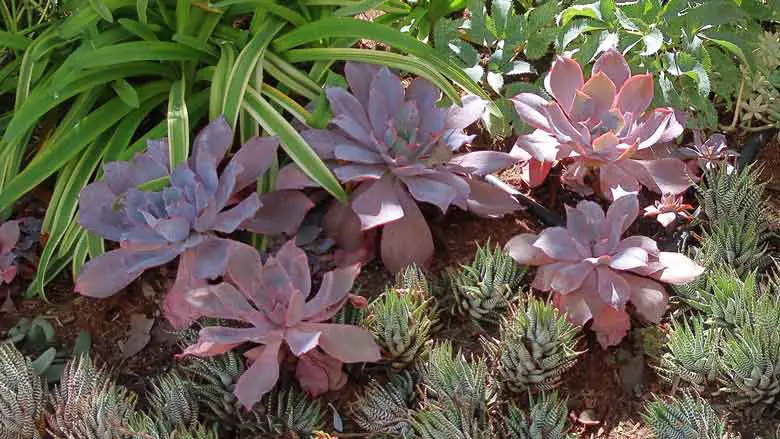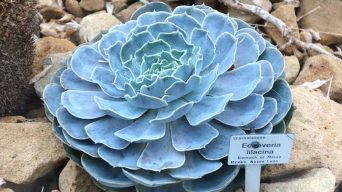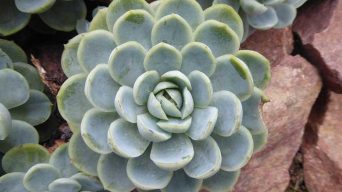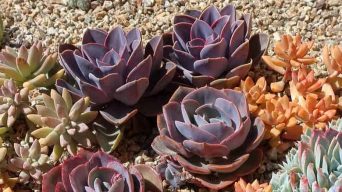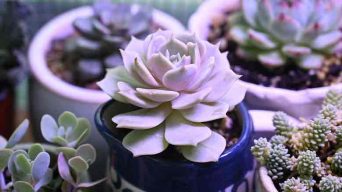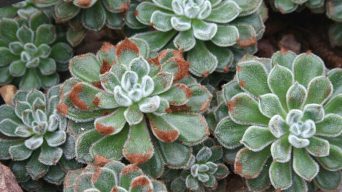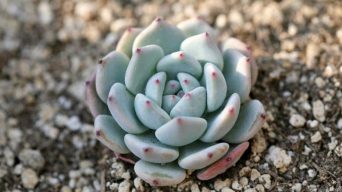The Echeveria Afterglow succulent plant is a beautiful, showy succulent that can be grown indoors and outdoors.
This complete guide will provide you with all the information you need to take care of and propagate your Echeveria Afterglow plants so you can grow a healthy and beautiful collection.
Echeveria Afterglow Description
Echeverias species are popular plants that are often used in the landscape or as container plants.
One of their most recognizable features is that they have rosette-shaped leaves and stand out with an attractive variegated color pattern on their leaf margins.
The Afterglow Echeveria variety adds great value to indoor gardening, landscaping, and rock gardens. They thrive well under different lighting conditions and can withstand less than perfect growing conditions effortlessly.
Echeverias come from Mexico, where there are over 170 species found so far (with many more still being researched). These include:
The most popular Echeverias are the hybrids, which have been developed by crossing different species of this plant with each other.
At first glance, they may resemble a cactus. Still, their thick leaves and flowers that bloom during the winter make them unmistakable from one another as succulent plants.
There is not just one type of Echeveria hybrid – there are many! Some examples are:
- Echeveria ‘Black Prince’
- Echeveria ‘Caesar’s Brother’
- Echeveria ‘Coralita Alba’
The Echeveria ‘Afterglow’ is a hybrid also known as echeveria x imbricata ‘Afterglow’. It is a hybrid of Echeveria Cante and the Echeveria Shaviana.
The Echeveria Afterglow is characterized by its round, succulent leaves with a beautiful blue-green coloration speckled by marbling in the center.
The flower of this plant has an orange and yellow halo around it, making it even more unique than other echeveria plants.
How To Care for Echeveria Afterglow
Echeveria ‘Afterglow’ succulents are a popular type of plant because they have such delicate and beautiful leaves.
With proper care, Echeverias should be able to grow for years with little help.
Sun Exposure & Light Requirements
Echeveria Afterglow plants require an amount of sun exposure that is fairly low.
They can grow in full shade to partial sunlight, but they will need a minimum of three hours per day with some direct bright light.
With more than four hours of sun exposure daily, the plant may have problems recovering from heat and other forms of stress during the night or winter months.
The leaves will dry up and become brown even if you water them. This happens because they cannot get enough moisture to grow.
Echeveria Afterglow plants need the right amount of light to stay happy. They will thrive in an area that receives some direct sun, but not too much.
A good rule is three hours or more, with at least four hours per day being ideal for healthy growth and flowering during the spring and summer seasons.
During winter months, they can survive on less than half the exposure so long as it provides them a way to keep warm through artificial means (like using grow lights).
Watering Echeveria ‘Afterglow’ Succulents
Echeveria Afterglow succulent plants need to be watered lightly and infrequently.
They should only be watered when the soil is completely dry. Still, you can also water them sparingly after being grown for some time, and their roots are established if desired.
Proper watering will provide a deep soaking up to about an inch below the surface of the potting mix. This may take ten minutes or more with larger Echeverias or planted in pots deeper than one inch.
Using a container with drainage holes at the bottom is always a good idea so excess water doesn’t sit stagnant on top of plant leaves, waiting for it to dry up.
Echeveria Afterglow care for watering means always using room temperature filtered tap water. Cold water may damage delicate new growths on succulents like these from Echeveria Afterglow propagation.
Never let the roots stay underwater for long periods because this could hurt the roots.
Soil Requirements
Echeveria Afterglow plants are tolerant of a wide variety of soils. Still, they will do their best in a soil mix for cacti and succulents or an African violet potting mix.
However, if you have an organic garden with composted manure available (or worm castings), it is better to use that as the primary growing medium. This produces higher yields than any generic potting mix does.
The most important part of the soil is to ensure it drains well. This prevents root rot and makes watering more effective, as less water will be retained in the potting mix.
Echeveria Afterglow plants do best when they are watered once a week from March through September, so long as their pots have drainage holes on the bottom.
These plants can survive very dry conditions for short periods – up to two weeks without any water at all!
Temperature and Humidity
Echeveria Afterglow plants require a moderate temperature and humidity level.
They tolerate both hot and cold temperatures, but avoiding the range between 15-33 degrees Celsius (59-91 degrees Fahrenheit) is best to discourage rot.
As for humidity levels, they should be kept at 40%-60%.
If your home has low humidity during the winter or very dry air conditions, then you may need to place the Echeverias outside on cool days so that their leaves can drink up some water from dew droplets overnight.
There are several ways to create humidity for your Echeveria plant.
First, you can place the plant on top of pebbles with water in an uncovered pot or container. This will cause condensation and give them enough moisture to grow without worrying about overwatering them.
You could also mist their leaves every week using distilled water from a spray bottle. This is helpful when looking for solutions if there’s not enough natural humidity in your home.
If you’re growing Echeverias outdoors during the summer, then slightly wetting down the soil once a day should do the trick (a light rain would be perfect).
When it’s colder outside, they’ll need more moisture in the winter months, and you can water them once every three days or so.
If your Echeveria succulent is in an area with low humidity (like a bathroom), placing a humidifier nearby will help create higher humidity levels.
Just be sure not to put the plant directly on top of the steam from the humidifier because this may dry out their leaves.
Fertilizing
Many succulent plants absorb nutrients through their leaves, so they don’t require an extensive feeding program.
However, if your Echeveria Afterglow plant is losing its color and does not have a healthy appearance, it may need more frequent fertilizing to help the soil retain moisture levels for its roots and stems.
It should be watered less frequently because this can affect root growth due to dehydration or overwatering.
The best time to water is in the morning when there are fewer hours of sunlight which evaporates water from ground coverings like gravel faster than at other times of the day.
The type of fertilizer you use on succulents depends mostly on how much light your Echeveria afterglow gets.
If your Echeveria Afterglow plant receives a lot of light, fertilizer with high nitrogen levels is best.
Succulents also need trace minerals like iron and zinc to thrive, so choosing fertilizers that include them is important.
Potting and Repotting
The type of pot for an Echeveria Afterglow plant will depend on the size of its root ball. In general, a pot should be three to five inches wider than the width of the root ball and at least an inch taller than it is wide.
The pot should have a hole at the bottom for drainage.
If you are using a clay or stoneware pot, be sure to use something like an organic compost that can hold moisture and nutrients when watered.
Otherwise, it may dry out quickly because water doesn’t drain through these pots well.
It is important not to put this plant in too large of a container, so make sure there is plenty of room around the edges for adequate soil depth and airflow.
It is necessary to transplant an Echeveria Afterglow plant into a new pot when the roots grow out of its original container.
The best time to repot is during dormancy (usually December through March). This allows enough time before putting outside again for the plant’s root system to recover from being disturbed.
Keep newly potted plants indoors until they are well adjusted – this will usually take about three months.
Then move them outdoors gradually as dictated by weather conditions and temperature changes in the outdoor environment.
To transplant an Echeveria Afterglow, it is recommended to:
- Use succulent potting soil or cacti and succulent mix. You can also use a 50/50 mixture of the two types.
- Ensure your pot has drainage holes to prevent root rot from excess water buildup. This is especially important during hot months when the plant will require more frequent watering.
- Water well before placing in the new container so you don’t disturb too many newly loosened roots with an empty root ball. Be careful not to overwater. This could lead to future problems like fungus infections on your echeveria afterglow plants’ leaves.
- Place the succulent in a bright location with adequate airflow.
Pruning
Trimming Echeveria is not required.
In fact, in the absence of any other growth-limiting factors, such as insufficient light or water, too much pruning can inhibit healthy plant growth.
Pinch off individual leaves that are dying on the tips and near rosette formation for aesthetic purposes only.
Pests and Diseases
Echeveria Afterglow is susceptible to a few pests and diseases.
Pests
The most common pest you will find on Echeveria are Mealybugs which can spread quickly if not controlled early, so you must keep up with these as soon as they’re noticed.
The easiest way to control Mealybug infestations is by washing them off of the plants in your home garden or greenhouse before they have time to settle down.
They could also be removed using an insecticidal soap or horticultural oil spray.
Diseases
Root rot is the most common disease that affects Echeveria Afterglow. It can be a big problem if not dealt with quickly.
The best way to control this issue is by watering your plant properly. Ensure they are watered at least once every week or two, depending on how hot the weather you have in your area.
One of the most prominent signs that your plant might have root rot is if it starts to droop or wilt, but there are other symptoms as well.
The leaves may start to turn brown and shrivel up before falling off, which could be a sign of too much water in certain spots on the plants-growing surface.
In addition, they might also appear wilted even when you’ve recently watered them, so make sure not to overdo it!
If this sounds like something your Echeveria Afterglow has been experiencing, then I would recommend repotting into fresh soil immediately for the best results.
How To Propagate Echeveria Afterglow Plants
To propagate an Echeveria Afterglow plant, you will need a few things:
- A clean plastic or glass container with drainage holes in the bottom. If it’s too big, cut away some of the lower sections so that it can fit into your pot without touching dirt on the sides.
- Soil for succulents is usually just cactus soil and perlite mixed at a ratio of three parts soil to one part perlite. You want enough to fill up your new container about halfway full with medium depth (so about two inches deep). Don’t use regular garden soil. It contains different types of bacteria that are good for plants like tomatoes but bad for succulent plants!
- A cutting from the mother plant.
To easily propagate Echeveria Afterglow, follow these steps:
- – Fill up your container with the soil.
- – Place the cutting into it and firm down around it so that there are no air pockets in between. The bottom of the stem should be about one inch below the surface of the soil. Make a cut across the leaf. Make sure that it is not too close to any flowers on the plant, or any new leaves will grow there.
- – Place the pot in a bright location. You can also use grow lights to help with this, but make sure you keep it out of direct sunlight, which might cause sunburn or wilt.
- – Water regularly and fertilize monthly using organic fertilizer (such as compost tea).
- – Keep the soil moist at all times by occasionally spraying – preferably during the hottest part of the day when plants are less active and water loss is minimal. In the winter months, reduce the watering frequency to once every two weeks so your succulent doesn’t dry out completely!
After about two months, you can harvest your new Echeveria Afterglow succulent plants!
They will have grown roots by this time and some small leaves as well.
Is the Echeveria Afterglow Toxic?
The Echeveria Afterglow plant is not toxic to humans or animals.
It does have a sap that can irritate the skin and eyes, so wash your hands after handling it.
Always use gloves if you want to propagate the succulent with cuttings, as this will reduce any risk of getting the sap on your skin.
Final Thoughts
The Echeveria Afterglow plants are a great way to add color and life to your space.
With the proper care and propagation methods, this echeveria afterglow succulent can be a beautiful houseplant.
Even if you are an inexperienced gardener or new to plants in general, it should not take long before your plant thrives for many years.

